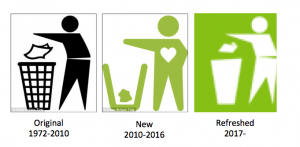Treasure and measure your brand assets
“Sometimes the original idea turns out to be better than its replacement,” correctly points out The Times this week, reporting on the re-introduction of the ‘Tidyman’ anti-litter logo that dates back to the 1970s. This follows an honest admission by the charity Keep Britain Tidy (KBT) that he was still much better recognised than his successor that was introduced six years ago (see below)

This little news column has some important lessons, that I discuss below.
1. Memory structure is hard to create (and forget)
Creating ‘memory structure’ takes time, with estimates suggesting you need two to three years of consistent marketing for people to properly encode a brand property. And once you have created the memory structure, its often bloody difficult to forget! KBT belatedly found out that Tidyman had a tidy amount of memory structure that was hard for people to ‘un-learn’, after almost 40 years of usage in many different applications, such as packaging and posters,
2. Treasure your assets
Brand properties, like the Tidyman logo, are valuable assets that deserve to be treasured. And yet decisions to ditch them are most often taken on judgement, usually linked to a change in organisation, such as a new Marketing Director or CEO, according to brandgym research (below); a mere 24% based on quantitative data.
I’ve often heard Marketing Directors say , “I feel we should change our logo (or slogan or pack design).” Maybe this was the case back in 2010 when KBT ditched the orginal logo to replace it with the new one. Now, can you imagine a VP of Manufacturing saying, “I feel we should knock down our factory that has been working well for many years,” without any supporting data or cost/benefit analysis? Probably not; they would likely be laughed out of the boardroom or even fired. And yet brand assets are created and dumped without hard data to back up the decision making, preventing the creation of distinctive memory structure and eroding brand equity.

3. Measure your assets
If you treasure your assets then you should measure them. “KBT decided to reintroduce the old logo, with small changes, after its research showed that more than eight out of ten adults recognised it,” reports The Times in their article. If this sort of study had been done back in 2010, they could have maybe saved a load of money and hassle.
On brandgym projects we use an ‘Iconic Asset Tracker’ (IcAT) study to measure brand properties and help brand owners make data-based decisions. Importantly, this uses an ‘implicit thinking’ approach, where people react to brand properties in less than a second. This highlights the iconic assets that are truly embedded in memory structure, as opposed to those recalled only after having thought about it.
An IcAT example on Magnum ice cream the brand’s most iconic asset ws the product shape, with a 93% ‘activation’ score (prompts recall of the brand); the brand’s distinctiveness is ‘baked in’ to the product itself. And showing a user biting into the product activates the brand much better than a generic ‘sensual indulgence’ image. In contrast, the brand’s slogan, ‘For pleasure seekers’, is less strong (41%), with 1/3 of people linking this to Häagen Dazs. Celebrities score much lower, with the most recent endorser, Benicio del Toro, scoring a lowly 21%.
4. Try fresh consistency first
Credit to KBT for deciding it was wrong to bin Tidyman. Their new approach to refresh the original logo makes a lot of sense. They have kept the basic visual shape, but simplified the form and used the green colour, which is linked to the environment. This is an example of what we call ‘fresh consistency’. As Keep Britain Tidy Ambassador and TV presenter Kirstie Allsopp said, “I am delighted that Keep Britain Tidy is giving Tidyman a new lease of life and to have had the opportunity to give him a hug!”
In conclusion, the death and re-birth of Tidyman is a good reminder to think twice before binning a brand property that has been built over many years. And if you are thinking of making a change, treasure and measure your brand asset.

